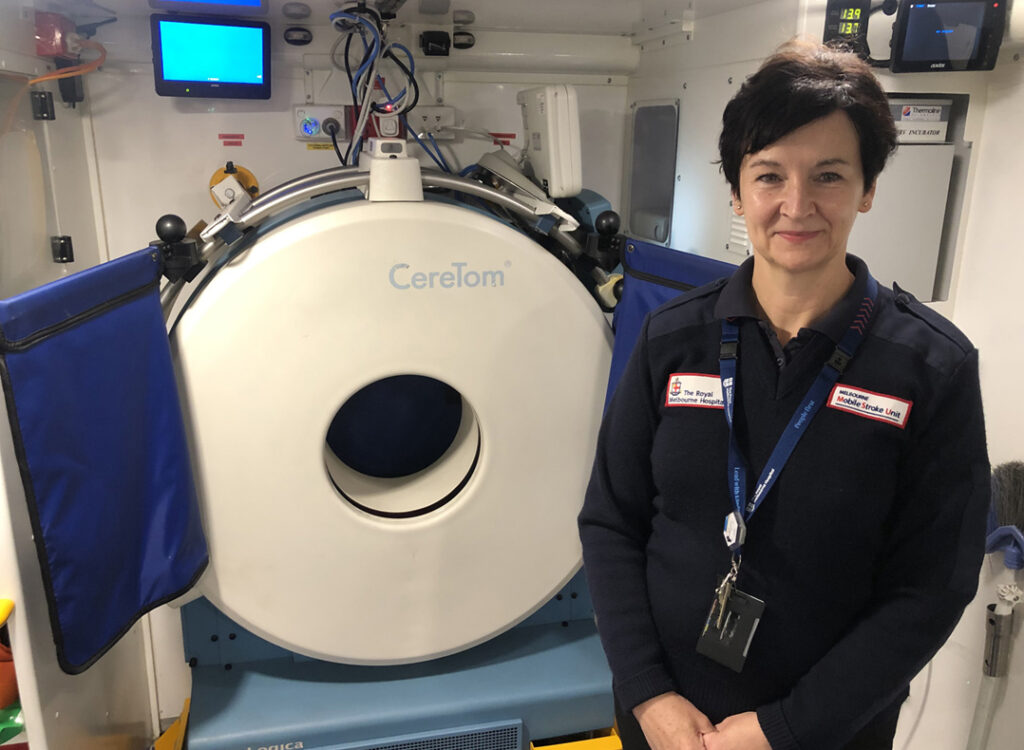Meet radiographer, Francesca Langenberg

Francesca Langenberg is in the business of saving millions and millions of brain cells. She’s a trailblazer for her profession as Australia’s first radiographer on the move, in an ambulance. Travelling at speed with her trusty portable CT brain scanner, Francesca is a member of the country’s first mobile stroke ambulance team, along with two paramedics, a stroke nurse and neurologist. While other ambulances pick up a patient and transport them to hospital for an essential brain scan, this team waits outside the vehicle at the scene of the stroke as Francesca calmly works inside, scanning the patient’s brain, to identify a clot or a bleed. Decisions are made quickly and, when possible, a clot-buster is given and the patient’s chances of recovery improve within moments.
Francesca is the CT team lead for the mobile stroke ambulance, training other radiographers. As well, she plays a critical role as our CT project lead across all our research streams bringing scanning to country roads and rural and remote skies. She brings technical and clinical expertise and more than 30 years’ experience.
Tell us about occupational exposure to radiation, especially given the tiny space you work in. And how do you manage risks when doing your job on roadsides?
One of the most common questions I’m asked relates to the safety around the operation of a CT scanner in the back of an ambulance. Before we went into operation the scatter radiation levels were precisely measured by a specialised radiation physicist. So, we know the safest places to stand during x-ray exposure.
The radiographer does remain on board during the scan which is actually very comforting for the patient. I can talk them through the scan, remind them to keep still and constantly reassure them. It helps a lot. It can be very scary for the patient and quite claustrophobic.
During a scan I wear a lead apron, thyroid shield and lead glasses and stand in the designated area of the ambulance; all this on top of full PPE which can get very uncomfortable, especially on hot days. From our radiation measurements I know that I would have to do 6000 brain scans in a year to reach the dose limit for a member of the public. The patient receives about the same dose as they would if they went to any major hospital for a brain scan.
The crew stands outside a 2-metre radius around the vehicle and ensure no members of the public breach that radius during a scan. I always call 'x-rays" loudly to alert everyone that I am about to scan. When I hear a verbal acknowledgment from the crew, I proceed.
You’re on the board of PRESTO, the PRE-Hospital Stroke Treatment Organisation. How are you influencing international stroke retrieval?
I am very honoured to be the radiographer representative on the board of PRESTO. It is an international group bringing together mobile stroke unit personnel from all around the world. We all share the same mission – to improve stroke outcomes for everyone no matter where they live. It’s a wonderful forum to discuss issues, celebrate successes and a marvellous education and research platform. Members are very keen to hear of our progress with the Australian Stroke Alliance research program which really is leading the world.
The Stroke Alliance has nearly 40 partners. You’re involved in several important streams, particularly with colleagues developing lightweight and portable scanners for fixed-wing and helicopter ambulances. How are they progressing?
My work with the Stroke Alliance is extremely exciting. I am so lucky to be involved and be able to contribute to its success. When I started radiography many, many years ago if you had told me I would be performing a CT scan in the street or on the side of the road I would have said you were crazy! Now it’s done every day.
And so, we are taking it a step further working with partners to develop lightweight portable imaging. Our partners are progressing really well and are showing a lot of promise. In fact, we will soon be starting an in-hospital clinical trial with one of our commercial partners, EMVision.
I get a lot of job satisfaction working with such innovative minds which also challenge me to think outside of my traditional CT training. I learnt very early that impossible is not a word in our vocabulary. Challenging, yes, but impossible, no.
What are some of the trickiest problems to overcome?
The biggest problem is size and weight of the CT scanner. The scanner we have on our ambulance weighs around 500kg and is the size of a large industrial washing machine. Our partners are designing equipment a fraction of that size and weight while aiming to maintain good image quality. The new technologies will need to be able to operate in all environmental conditions, which is a challenge.
What professional skills do in-field radiographers need to develop?
Unfortunately, if you suffer from motion sickness this is not the role for you. We can spend long periods of time in the rear of the ambulance driving from job to job. We also work in rain, hail or shine and, of course, the radiology department is outside a person’s house or soon, on a runway in the outback. A mobile radiographer needs to be able to work calmly and efficiently under time pressure and be able to work independently. There is no one in the next room to ask for help.